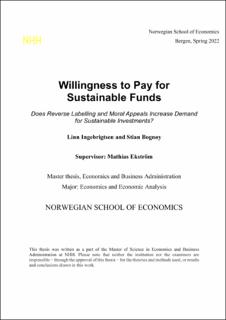Willingness to Pay for Sustainable Funds: Does Reverse Labelling and Moral Appeals Increase Demand for Sustainable Investments?
Master thesis
Permanent lenke
https://hdl.handle.net/11250/3015931Utgivelsesdato
2022Metadata
Vis full innførselSamlinger
- Master Thesis [4372]
Sammendrag
This thesis seeks to determine if there is a willingness to pay for sustainable funds and if it is
possible to influence the willingness to pay through a reverse label- and a moral treatment.
The study also investigates the impact of the demographic factors age, gender, income,
education, and knowledge.
We study this topic by gathering data from an experimental survey sent to customers of
Storebrand in Norway. The sample of 400 respondents is exposed to the treatments in a 2x2
between subject design. The willingness to pay is determined through a hypothetical question
where the respondents are asked what they are willing to pay in management fee for a
sustainable fund, and still prefer this over an otherwise comparable non-sustainable fund with
a management fee of 1%. With standard labelling they are reporting their willingness to pay
for “Global sustainable” compared to “Global”. With reverse labelling they are reporting their
willingness to pay for “Global” compared to “Global non-sustainable”. The moral treatment
consists of a moral text before the question of willingness to pay.
The results suggest that there is a willingness to pay for sustainable funds, and that this
willingness can be increased by exposing respondents to a combination of both treatments.
Furthermore, the moral treatment is effective in increasing the probability of the respondents
being willing to pay. In total, the number of respondents who had a willingness to pay for
sustainable funds was 34% in the control group. This number increased to 49% for the groups
who were exposed to a treatment. Receiving the combination of both treatments almost tripled
the willingness to pay for sustainable funds as the average management fee people accepted
went from 1.25% to 1.69%, an increase of 0.44 percentage points. The demographic factor of
having a gross annual salary of more than 700,000 NOK is showed to have a negative
correlation with willingness to pay for sustainable funds. However, gender, education, and
knowledge were not significant, and neither was age when removing outliers.
